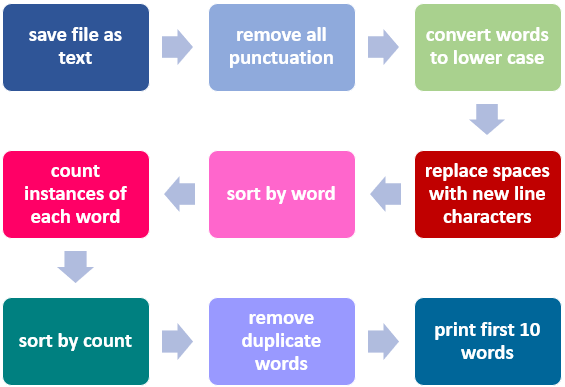Computational thinking in programming
Last updated on 2024-11-12 | Edit this page
Estimated time: 40 minutes
Overview
Questions
- Why is decomposition crucial in programming?
- How can we break down a problem like counting words in a text?
- What is the difference between linear and branching code?
- How can pattern recognition help in programming?
Objectives
- Understand the importance of decomposition in programming
- Learn how to break down a problem into discrete parts for programming
- Recognize the difference between linear and branching code
- Apply pattern recognition to adapt existing code for new problems
Decomposition is crucial in any kind of problem breakdown, but especially so in programming. The computer must be told precisely what to do, and in what order, so problems must be broken down into discrete parts and each section coded appropriately.
Suppose we want to find the ten words most commonly used in a text. How might we go about that?
Linear code
While there are many different ways to do this task, this is one way, where all the commands are run in a linear sequence, e.g.,

First we save the file in .txt format to eliminate all
the “smart” formatting created by programs like Word (as they would
otherwise introduce a messy bunch of extraneous characters). Then we
progressively eliminate everything from the text that is not a word,
i.e. punctuation.
Converting all the words to lower case means we end up with a single
version of each word - not two. This is important because, to a
computer, Word (starting with an upper case letter) does
not equal word (starting with a lower case letter) - it
treats them as two separate entities.
By replacing spaces with new line characters, each word
will end up on its own line, which makes them easy to sort
alphabetically and then count.
Each part of the sequence would need to be individually programmed. Fortunately, programmers can adapt code that others have already used to do similar tasks, such as code to identify letter, number or word frequency. Once you are coding, this is where the computational thinking skill of pattern recognition comes in - identifying similar code that can be used for or adapted to the specific problem you want to solve.
Branching code
Programming rarely works in such a linear fashion. Code generally
includes branching so that different pathways can be taken, depending on
whether or not certain conditions are met, e.g., different responses to
a Yes/No or True/False decision, as in the
example here.

Hiking Preparation Strategy
Our friends have finally made it out of the forest and back to civilisation. Their experience, while unpleasant, has not put them off hiking. Draw a structure diagram of the planning they need to do for next time to avert another disaster.
Key Points
- Decomposition is essential for breaking down problems into discrete parts in programming.
- Computers require precise instructions, and problems must be broken down accordingly.
- Linear code runs commands in a sequence, while branching code allows for different pathways based on conditions.
- Pattern recognition helps programmers adapt existing code for new problems.
